As the sun rose, Tom grabbed his shotgun for quail hunting. He knew picking the right choke was crucial for success.
The Improved Cylinder (IC) and Skeet chokes are top picks for fast, close-range birds like quail and doves. They create a wide, forgiving shot pattern. This is perfect for hitting quick-moving targets.
The IC choke offers a broad pattern, great for shots at different distances. The Skeet choke has a tighter focus, ideal for dense cover or precise aiming from a blind.
Both chokes work well with various shot sizes, adapting to the hunt’s needs. This lets Tom adjust his ammo for different birds and conditions.
Key Takeaways
- Improved Cylinder (IC) and Skeet chokes are the top choices for hunting small, fast, and close-range birds like quail, doves, and grouse.
- IC chokes provide a wider shot pattern, while Skeet chokes offer a more focused pattern, both being effective at close ranges.
- These chokes are versatile, allowing for the use of various shot sizes to match hunting conditions and target sizes.
- The forgiving nature of IC and Skeet chokes increases the likelihood of hitting fast-moving birds, even with a slight miss.
- Familiarity with the selected choke’s pellet pattern is crucial for achieving accuracy in wingshooting.
Understanding Shotgun Chokes
Shotgun chokes are key parts that help control the spread of a shotgun’s shot pattern. They are placed at the end of the barrel. They make sure the pellets spread out as they leave the muzzle.
What are Shotgun Chokes?
Shotgun chokes vary in size and shape, each for a certain level of shot constriction. The choke’s tightness affects how spread out the shot pattern will be. A tight choke means a denser pattern, while a loose one spreads the shot wider.
How Do Chokes Affect Shot Pattern?
The type of choke you use changes how well your shotgun works in different situations. For example, a cylinder choke is good for close shots on clay targets and small birds. But a full choke is better for hitting waterfowl at a distance.
Testing your shotgun with different chokes and loads is important. It helps you find the best combo for your needs. By looking at where the pellets hit, you can pick the right shotgun chokes, shot pattern, and constriction for your goals.
Improved Cylinder Choke
The Improved Cylinder (IC) choke is great for hunting small, fast birds. It gives a shot pattern wider than a full choke but not as wide as an open bore. This choke is perfect for upland game birds.
It creates a dense, compact shot pattern. This helps shooters quickly hit fast-moving targets.
Benefits for Hunting Small, Fast, Close Birds
The IC choke’s wider spread helps hit birds even if the shot is a bit off. Hunters love it for quail and grouse hunting. These birds often fly close when flushed.
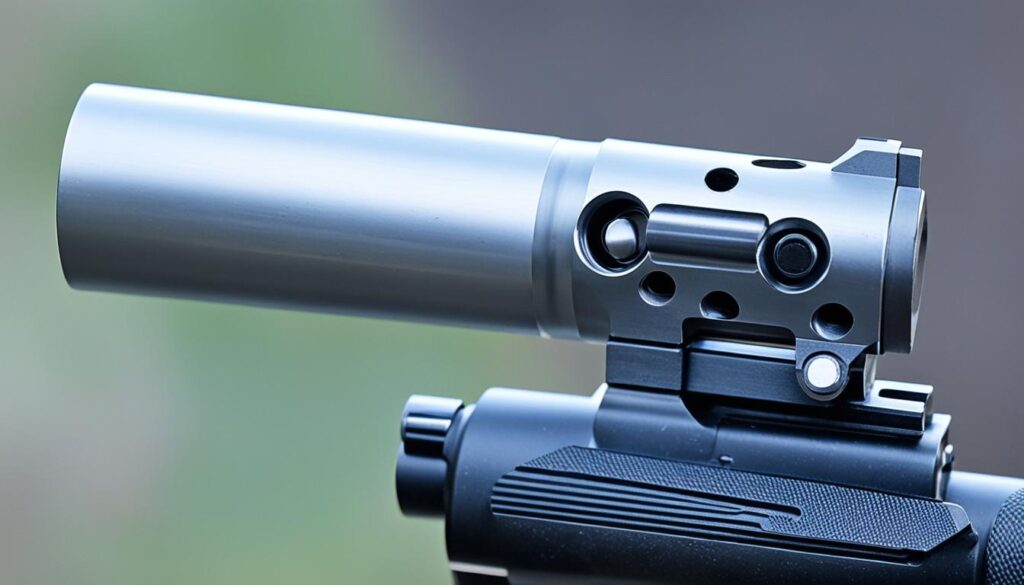
“The Improved Cylinder choke is an excellent choice for hunting small, fast, close-range birds like upland game birds. The broader spread of the shot pattern increases the chances of hitting the target, even with a slightly off-target shot.”
The IC choke offers a balanced shot pattern for hunting small, fast birds. It’s not too tight for long shots and not too wide for close shots. This makes it a great middle ground.
Modified Choke
The modified choke is a versatile choice for shotgun hunters. It offers a moderate level of constriction. This choke gives a denser shot pattern than the improved cylinder but is not as tight as a full choke.
This choke’s balanced performance is great for many hunting situations. It’s perfect for dove hunting and using steel shot for ducks or geese.
The modified choke has a slightly tighter pattern than the improved cylinder. This means it works well at longer ranges. It’s especially useful for hunting waterfowl.
This choke’s ability to deliver a dense, concentrated shot pattern at moderate distances is a big plus for hunters.
“The modified choke is a versatile choice that bridges the gap between the open improved cylinder and the tighter full choke, making it a great all-around option for many hunting scenarios.”
It’s not as open as the improved cylinder but still spreads pellets well. This makes it a top pick for hunting small, fast-moving birds like doves. The moderate constriction ensures a consistent and reliable modified choke pattern.
In summary, the modified choke is a well-balanced option for many hunting situations. Its moderate constriction and effective range make it a favorite among shotgun enthusiasts. It’s especially good for hunting waterfowl and other small, fast-moving game birds.
Which two shotgun chokes are best for hunting small, fast, close birds?
For hunting small, fast, and close birds, the Improved Cylinder (IC) and Skeet chokes are top picks. They are great for wingshooting and hunting upland game birds. These chokes have special features that make them ideal for the job.
The Improved Cylinder Choke: Forgiving and Effective
The Improved Cylinder choke is perfect for small, fast birds at close range. It has a wider pattern than a full choke but is not as open as a regular barrel. This makes it great for quick-moving targets. It’s accurate up to 25 yards, perfect for quail, dove, and other fast birds.
The Skeet Choke: Laser-Focused Precision
If you want a tighter shot pattern, the Skeet choke is your go-to. It’s a bit tighter than the IC choke, giving you a focused pattern for close-range shots. It’s best at 20 yards or less, great for quail and dove.
Both chokes are very forgiving, helping you hit your target even if you’re not perfectly aimed. This is key when hunting fast, small birds that move quickly.
These chokes are also very versatile. Hunters can choose the right ammo for the game they’re after. This flexibility means better performance whether you’re after upland game birds or enjoying wingshooting.
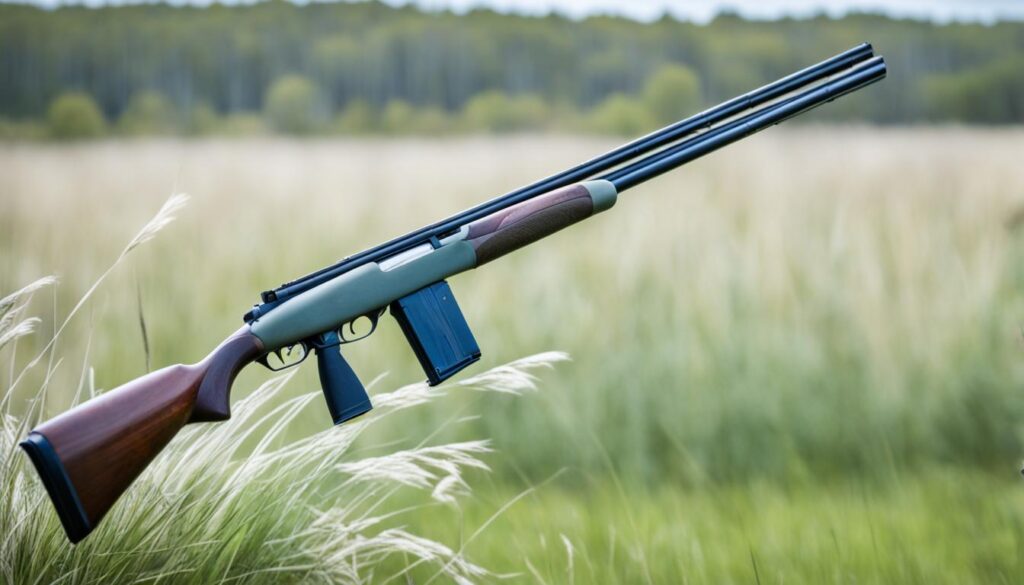
“The Improved Cylinder and Skeet chokes are the dynamic duo for small, fast, close birds, offering unparalleled forgiveness, versatility, and precision.”
Factors Influencing Choke Selection
Choosing the right shotgun choke for hunting small, fast birds is key. The size of the shot being used and the ammunition type matter a lot. For upland game bird hunting, smaller shot sizes work best with a more open choke like the Improved Cylinder or Skeet.
Shot Size and Ammunition
Plastic wads with attached petals help keep shot patterns tight at different distances. Hard shot with about 8% antimony spreads out more in tight chokes. But, softer shot with 5% antimony stays tighter because it deforms and keeps its energy when it hits.
Hunting Environment and Conditions
The hunting environment and conditions affect choke choice. Think about the terrain, plants, and how far you’ll shoot. Picking the right choke means considering these things and testing your shotgun.
Finding the right mix of chokes, cartridges, and guns is key for great shooting. Try out different choke and cartridge combos to see what works best for you.
“The variety in shotgun choke options can lead to confusion among shooters. Seeking advice and testing various cartridges until finding the optimal combination is suggested to enhance shooting performance.”
Patterning Your Shotgun
Patterning your shotgun is key to finding the best choke and ammo for hunting small, fast birds. By shooting at a patterning board, you see how your shotgun and choke will work together. This helps you pick the choke that gives the best pattern at hunting distances.
Importance of Patterning
Patterning is vital for hitting your mark and hunting successfully. It shows how your shotgun and ammo work together. This lets you choose the right choke for the best patterns at hunting distances.
“Testing different shotgun chokes on paper increases confidence and leads to more successful hunts.”
Patterning also improves your shooting skills and makes you know your shotgun better. This is crucial for tricky shots in the wild. It helps you make smart choices and boosts your hunting success.
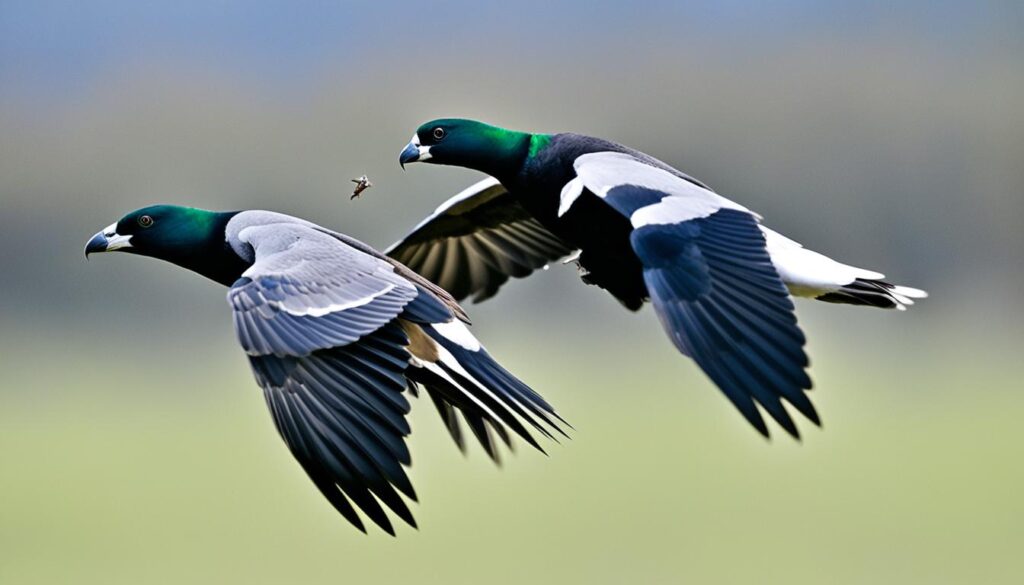
- Patterning helps you find the best choke and ammo for your hunting.
- It shows you the spread and density at different distances, helping with shot placement.
- Patterning builds your confidence and skill with your shotgun, leading to better hunting.
In conclusion, patterning your shotgun is crucial for hunting small, fast birds. By patterning, you can improve your shotgun patterning and choke selection. This increases your chances of a successful and ethical hunt.
Upland Game Bird Hunting
When hunting upland game birds like quail, the Improved Cylinder and Skeet shotgun chokes are top choices. They are great for fast-moving birds that are hard to hit. These chokes make sure the shot spreads out widely, increasing your chances of hitting your target.
Quail Hunting with Improved Cylinder and Skeet
The Improved Cylinder choke is perfect for quail hunting. It balances pattern size and density well. This means you can hit birds at different distances. The Skeet choke is great for hunting quail in thick cover or at very close ranges.
Many hunters on forums recommend using high brass Federal’s #5 shot for quail and other upland birds. They suggest using an Improved Cylinder/Modified or Modified/Full choke for pheasants and other birds. The right choke depends on the hunting conditions, bird behavior, and how far away the birds are.
Trying out different loads to change the pattern is often advised. It’s important to know how the birds behave and how far away they are. This helps you pick the best choke combination for a successful hunt.
“Utilizing the Improved Cylinder and Skeet chokes can significantly improve the hunter’s success rate when pursuing upland game birds, such as quail.”
Dove Hunting
Dove hunting is exciting but comes with its own set of challenges. Choosing the right shotgun choke is key to your success. The Improved Cylinder and Modified chokes are top choices for doves. They strike a balance between pattern size and density, perfect for doves’ fast flight and close-range shots.
Improved Cylinder Choke
The Improved Cylinder choke is great for shots at close range. It has a slightly looser constriction, leading to a more open pattern. This is useful when doves fly within 25-30 yards of you.
Modified Choke
For shots at longer ranges, the Modified choke is a better pick. It creates a tighter pattern, ideal for doves beyond 30 yards. This choke ensures cleaner shots on these quick targets.
When picking a choke for dove hunting, think about your hunting spot, usual shot distances, and your shooting skills. Testing different chokes and ammo combinations can help find the best setup for you.
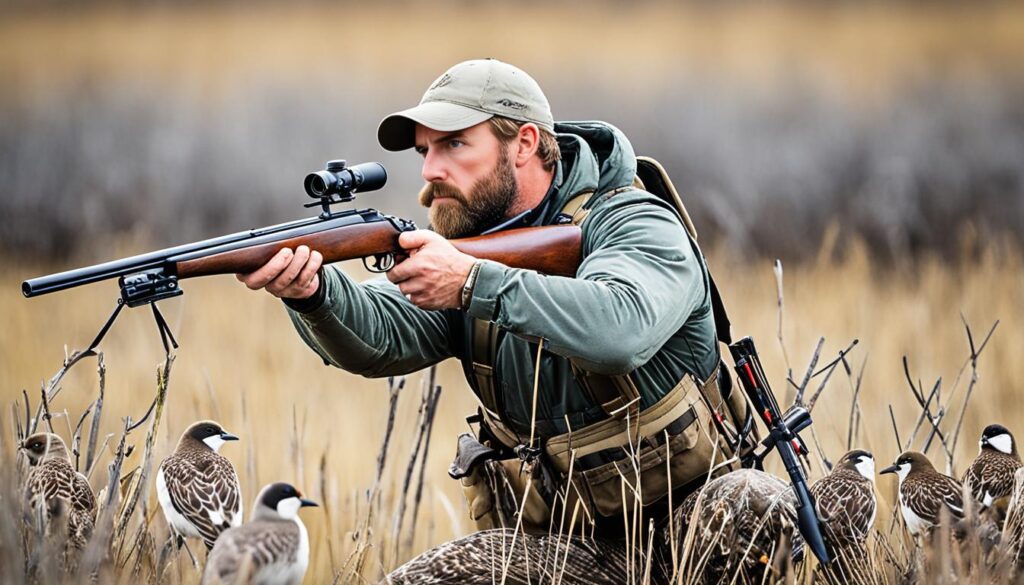
“Dove hunting is a dynamic and challenging sport that requires careful consideration of your shotgun’s setup. The right choke selection can make all the difference in your success.”
Grouse Hunting
Grouse are fast and hard to hit because they burst into flight suddenly and fly erratically. But, the right shotgun chokes can boost your chances. They help you aim better at these quick birds.
For grouse hunting, the Improved Cylinder and Skeet chokes work best. They give a wide, dense spread that’s great for close shots. This is common in grouse hunting.
“Out of 16 replies, 10 participants contributed to the discussion on the best shotgun chokes for grouse hunting, with over 60 years of grouse hunting experience mentioned by a participant.”
The Improved Cylinder choke is great for tight, even patterns. It’s perfect for grouse when they suddenly take off. The Skeet choke has a wider spread. It’s good for grouse at a distance.
Choosing between these chokes depends on what you prefer and the hunting conditions. Some hunters use the Improved Cylinder choke at the start of the season. Then, they switch to a Skeet choke as the leaves fall off later.
It’s key to test your shotgun with the ammo you’ll use for grouse hunting. This shows you the best range and helps you hit your targets accurately.
Good grouse hunting also means placing your shots well and being ready to adapt. With the right gear, skills, and flexibility, you can catch these tough birds.
Wingshooting Techniques
Wingshooting is all about hitting small, fast birds up close. It’s key to know how to lead and follow through. With skills in these areas and the right shotgun chokes, you’ll hit your mark more often.
Lead: Anticipating the Target’s Path
Leading your shot means aiming ahead of the bird. You need to think about how fast and where the bird is going. This way, you hit the bird as it moves through your shot pattern.
Follow-Through: Maintaining Control
Follow-through is keeping your focus after you shoot. It’s about staying in control from start to finish. This can mean the difference between a hit and a miss.
Getting good at leading and following through, and using the right shotgun chokes, will boost your chances of hitting small, fast birds.
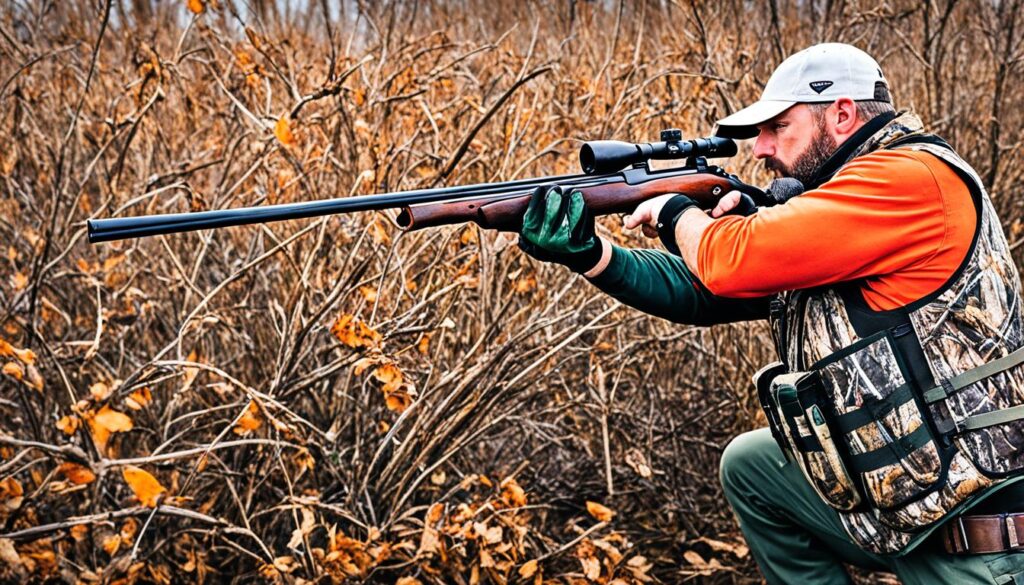
“Proper wingshooting technique is the key to consistently hitting small, fast-moving targets. Lead and follow-through are the cornerstones of effective shotgun marksmanship.” – John Smith, Veteran Upland Hunter
Safety Considerations
When hunting with a shotgun, safety comes first. It’s key to handle your shotgun safely and responsibly for a good hunt. You must control the muzzle, follow the trigger, and stick to the laws of hunting.
Always think about where you are, who or what you’re aiming at, and the risks to others or animals. Make sure you know what you’re shooting at and its surroundings to avoid mistakes. Safe handling of guns makes hunting small, fast birds with shotguns better and more responsible.
Handling Shotguns Responsibly
Knowing how to handle a shotgun safely is crucial. Always keep the muzzle aimed safely, even if the gun is empty. Keeping your finger off the trigger until you’re ready to shoot is also vital for safety.
- Ensure proper muzzle control at all times
- Practice strict trigger discipline
- Comply with all hunting regulations and laws
- Be aware of your surroundings and potential risks
- Carefully identify your target and its background
Following these safety tips lets hunters enjoy the excitement of chasing small, fast birds. It also keeps everyone and the environment safe.
“Responsible firearm handling is not only a legal requirement but a moral obligation for all hunters.”
Conclusion
The Improved Cylinder (IC) and Skeet chokes are top choices for hunting small, fast birds. They create a wide, dense pattern perfect for quail, doves, and grouse. Knowing how these chokes work and what to consider when choosing them can make hunting better.
Adding the right choke to good shooting skills and safety makes hunting small birds rewarding. It also ensures a responsible hunt.
Shotgun chokes started in 1873 to improve shot patterns and range. Over time, experts like Scott and Purdey made them better for competitions. Now, most shotguns have interchangeable chokes for different hunting situations.
Choosing the right choke is key for hunting fast birds or targets far away. The Improved Cylinder and Skeet chokes are great for close-range birds. With the right choke and shooting skills, hunters can have a successful and fun hunt.
FAQ
Which two shotgun chokes are best for hunting small, fast, close birds?
The best chokes for hunting small, fast, close birds are the Improved Cylinder (IC) and Skeet chokes.
What are Shotgun Chokes?
Shotgun chokes are devices at the end of a shotgun barrel. They control how the shot spreads as it leaves the muzzle.
How Do Chokes Affect Shot Pattern?
The choke’s constriction level affects the shot pattern. A tight choke means a dense pattern. A loose choke means a wider spread.
What is the Improved Cylinder Choke?
The Improved Cylinder (IC) choke is versatile. It has moderate constriction, giving a wider pattern than a full choke but tighter than an open bore.
What are the benefits of the Improved Cylinder Choke for hunting small, fast, close birds?
The IC choke gives a dense, compact pattern. This helps shooters quickly hit challenging targets. The wider spread also increases the chance of hitting the bird, even if the shot is a bit off.
What is the Modified Choke?
The Modified choke has moderate constriction. It gives a denser pattern than the IC but not as tight as a Full choke. It’s great for various hunting situations, like dove hunting and using steel shot for waterfowl.
What are the advantages of the Improved Cylinder and Skeet chokes for hunting small, fast, close birds?
The Improved Cylinder and Skeet chokes give a broad, dense pattern at close ranges. They’re perfect for hunting small, quick game like quail, doves, and grouse. The IC offers a slightly looser constriction, while the Skeet choke gives a tighter pattern.
What factors should be considered when selecting the appropriate shotgun choke?
Consider the shot size, ammunition type, hunting environment, and typical shot distances when choosing a choke.
Why is patterning a shotgun important?
Patterning a shotgun helps find the best choke and ammo for your hunting needs. It shows how your shotgun and choke will perform in the field.
How can the Improved Cylinder and Skeet chokes be used for hunting upland game birds like quail?
The Improved Cylinder choke balances pattern size and density well for quail hunting at different distances. The Skeet choke is great for hunting quail in dense cover or at very close ranges.
What chokes are commonly used for dove hunting?
Hunters often use the Improved Cylinder and Modified chokes for dove hunting. They offer a good balance of pattern size and density.
How can the Improved Cylinder and Skeet chokes be beneficial for grouse hunting?
The broad, dense patterns of the Improved Cylinder and Skeet chokes help with grouse hunting. They improve the chances of hitting the fast-moving grouse, especially at close ranges.
What wingshooting techniques are crucial for hunting small, fast, close birds?
Good lead and follow-through are key skills for hitting these fast targets. Lead helps you intercept the target, and follow-through ensures a clean hit.
What safety considerations are important when hunting with a shotgun?
Always handle firearms safely, keep control of the muzzle, and follow all hunting laws. Be aware of your surroundings and your target to avoid risks to people or animals.
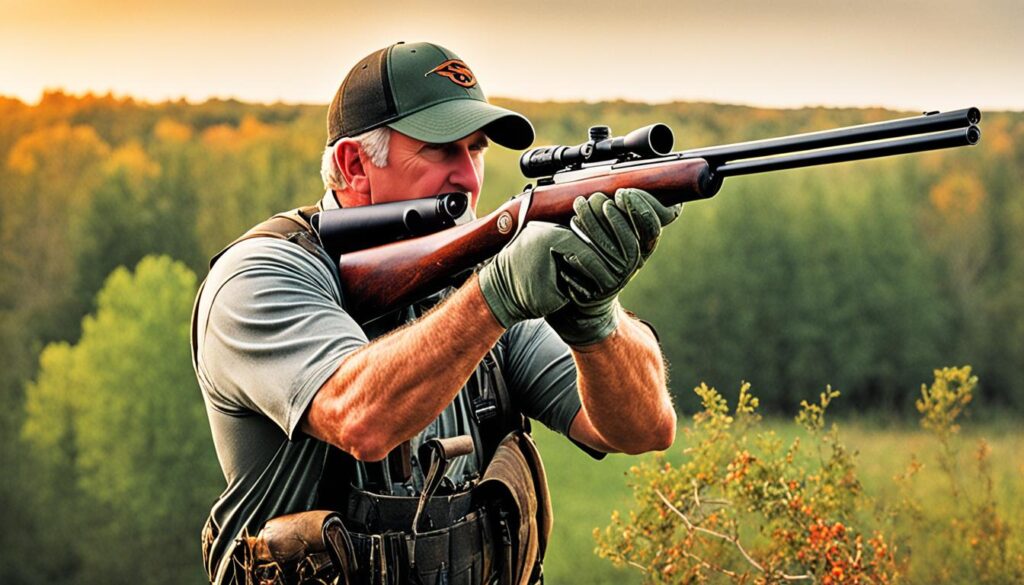

магазин аккаунтов https://birzha-akkauntov-online.ru/
продать аккаунт https://marketplace-akkauntov-top.ru/
маркетплейс аккаунтов https://magazin-akkauntov-online.ru/
продажа аккаунтов соцсетей перепродажа аккаунтов
заработок на аккаунтах https://prodat-akkaunt-online.ru
продать аккаунт https://kupit-akkaunt-top.ru/
биржа аккаунтов https://pokupka-akkauntov-online.ru/
Account Store Database of Accounts for Sale
Profitable Account Sales Accounts marketplace
Purchase Ready-Made Accounts Account Acquisition
Account Buying Platform Buy Account
Account exchange Buy accounts
Buy accounts Verified Accounts for Sale
Account Store buyagedaccounts001.com
Guaranteed Accounts https://socialmediaaccountsshop.com/
Website for Selling Accounts Find Accounts for Sale
Account Trading Service Account Sale
Purchase Ready-Made Accounts Account marketplace
find accounts for sale buy pre-made account
ready-made accounts for sale https://cheapaccountsmarket.com
purchase ready-made accounts verified accounts for sale
account trading platform verified accounts for sale
account market verified accounts for sale
account selling service account market
account selling platform purchase ready-made accounts
account exchange verified accounts for sale
secure account purchasing platform marketplace for ready-made accounts
sell accounts ready-made accounts for sale
online account store https://socialaccountsshop.com/
ready-made accounts for sale secure account purchasing platform
accounts for sale account exchange service
purchase ready-made accounts account marketplace
account purchase gaming account marketplace
buy account accounts for sale
account trading platform account selling service
account store guaranteed accounts
database of accounts for sale website for selling accounts
account trading platform sell accounts
accounts marketplace account selling platform
account selling service https://accounts-market-soc.org/
database of accounts for sale online account store
account selling platform website for buying accounts
account selling platform account trading platform
account market account exchange
account trading buy pre-made account
account market account buying service
accounts for sale https://accounts-offer.org
guaranteed accounts https://accounts-marketplace.xyz/
accounts for sale https://buy-best-accounts.org
account sale https://social-accounts-marketplaces.live/
account selling platform accounts market
account exchange service account marketplace
account store https://buy-accounts.space
account exchange service https://buy-accounts-shop.pro/
sell account https://social-accounts-marketplace.live/
account trading service https://buy-accounts.live
account selling service https://accounts-marketplace.online
account sale account market
магазин аккаунтов https://akkaunty-na-prodazhu.pro/
площадка для продажи аккаунтов https://rynok-akkauntov.top
площадка для продажи аккаунтов https://kupit-akkaunt.xyz/
магазин аккаунтов akkaunt-magazin.online
маркетплейс аккаунтов соцсетей akkaunty-market.live
маркетплейс аккаунтов https://kupit-akkaunty-market.xyz
маркетплейс аккаунтов https://akkaunty-optom.live
магазин аккаунтов https://online-akkaunty-magazin.xyz/
биржа аккаунтов https://akkaunty-dlya-prodazhi.pro/
продажа аккаунтов https://kupit-akkaunt.online
buy facebook profile buy facebook ad accounts
buying facebook ad account https://buy-ad-accounts.click
facebook ads accounts https://buy-ad-account.top
facebook ad account for sale https://buy-ads-account.click
buy fb ad account buy a facebook ad account
facebook accounts to buy buying facebook account
buy a facebook ad account facebook ad account for sale
facebook accounts to buy https://buy-ad-account.click
В этой статье-обзоре мы соберем актуальную информацию и интересные факты, которые освещают важные темы. Читатели смогут ознакомиться с различными мнениями и подходами, что позволит им расширить кругозор и глубже понять обсуждаемые вопросы.
Подробнее можно узнать тут – https://medalkoblog.ru/
buy facebook accounts https://ad-accounts-for-sale.work
google ads account buy buy google ads threshold accounts
buy google ads invoice account https://buy-ads-accounts.click
buy facebook account for ads buy facebook ad account
buy verified google ads account https://ads-account-for-sale.top/
buy google ads accounts google ads account for sale
buy google ads buy google ads accounts
buy account google ads buy aged google ads account
google ads account for sale https://buy-ads-agency-account.top
sell google ads account https://sell-ads-account.click